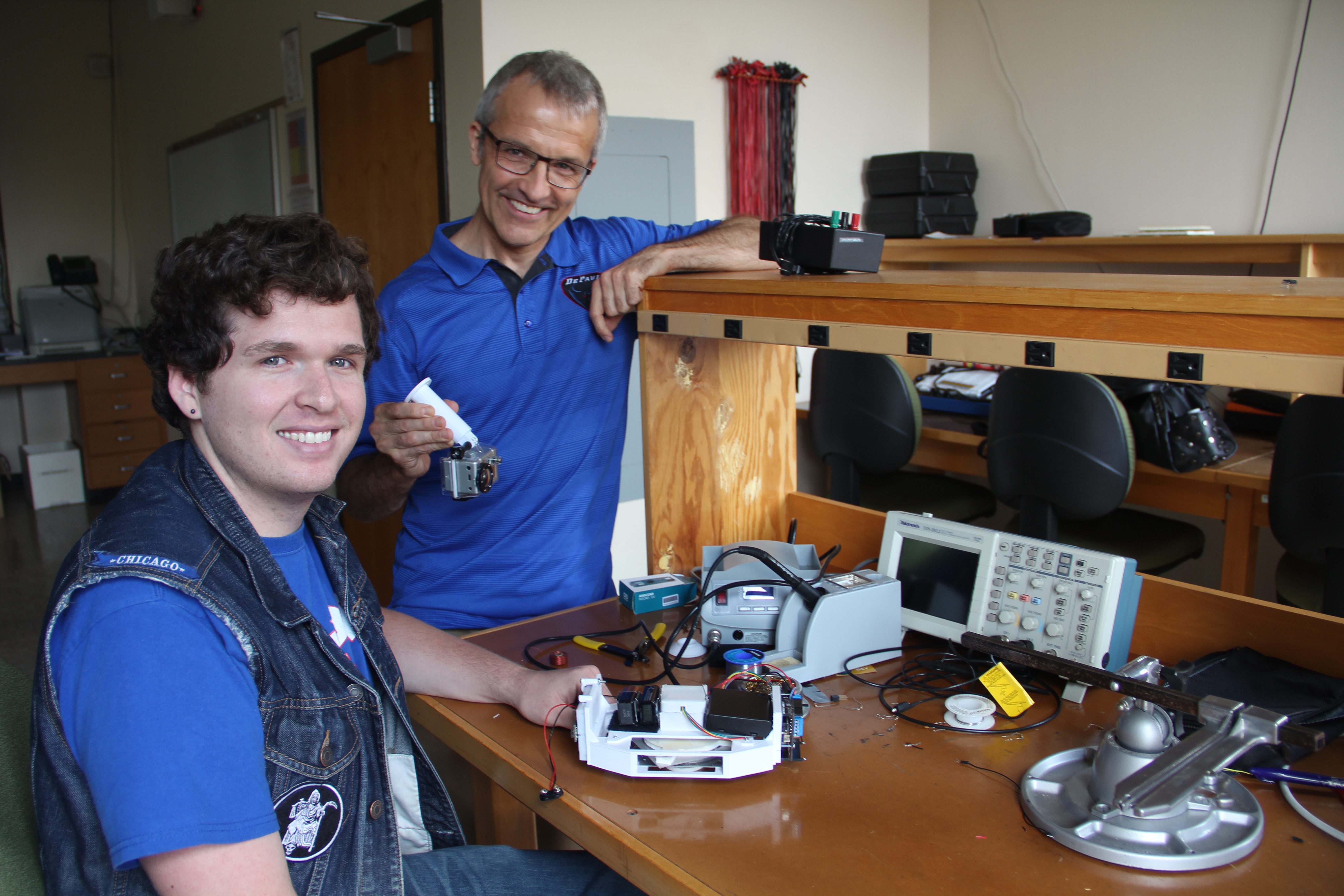 Bob Coulson, left, a DePaul University sophomore, and professor Bernhard Beck-Winchatz, at the workbench in the physics department where Coulson build a camera system device whose mission is to capture a staple video of the moon’s shadow as it moves across Earth during the Aug. 21 total solar eclipse. (DePaul University/Carol Hughes)
Bob Coulson, left, a DePaul University sophomore, and professor Bernhard Beck-Winchatz, at the workbench in the physics department where Coulson build a camera system device whose mission is to capture a staple video of the moon’s shadow as it moves across Earth during the Aug. 21 total solar eclipse. (DePaul University/Carol Hughes)CHICAGO — While many Americans will be looking skyward Aug. 21 during the total solar eclipse, if all goes according to plan, a camera system device built by a DePaul University physics major will be tethered to a high altitude balloon and pointed down as it ascends to a height of some 20 miles above Earth.
 A Controlled Heading Automation Device and payload arm (top) and a cylindrical attachment to connect a small GoPro camera (bottom) were built using a 3-D printer by physics major Bob Coulson. (DePaul University/Carol Hughes)
A Controlled Heading Automation Device and payload arm (top) and a cylindrical attachment to connect a small GoPro camera (bottom) were built using a 3-D printer by physics major Bob Coulson. (DePaul University/Carol Hughes)DePaul sophomore Bob Coulson, used a 3-D printer to build a Controlled Heading Automation Device — CHAD — about the size of an old VHS tape — as well as a payload arm and a cylindrical attachment to connect a small GoPro camera. The device holds a number of sensors — magnetometer, gyroscope and accelerometer — as well as a stepper motor, batteries and an Arduino Micro, a microcontroller board that serves as a tiny computer.
The job of the Arduino, which is smaller than most USB drives, is to read the data from the sensors and keep the GoPro stable and pointed in the right direction, said Bernhard Beck-Winchatz, a professor of physics who oversees a grant from the Illinois Space Grant Consortium, a NASA education program. The grant supports undergraduate research projects, like Coulson’s mission to see if his camera system can track the moon’s shadow from above as it moves across Earth.
“The research goal is really about building and improving a device to capture staple video,” noted Beck-Winchatz, an astrophysicist and expert in high altitude balloons.
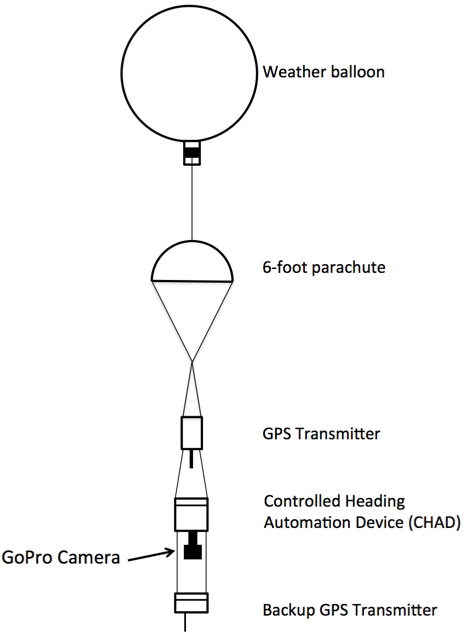 A schematic of the high altitude balloon, parachute, tracking devices and payload. (DePaul University/Bernhard Beck-Winchatz)Getting into the stratosphere
A schematic of the high altitude balloon, parachute, tracking devices and payload. (DePaul University/Bernhard Beck-Winchatz)Getting into the stratosphere
A nearly 8-foot wide helium-filled balloon carrying Coulson’s eclipse camera system and several tracking devices anchored to dangling strings, will be launched late in the morning Aug. 21 from Perryville Regional Airport in Missouri, about 80 miles southeast of St. Louis. It will launch with five other high altitude balloon missions being coordinated by the Adler Planetarium Far Horizons Project.
At the Perryville location, the eclipse will begin shortly before noon with totality lasting about 2 minutes and 40 seconds at around 1:18 p.m. According to Beck-Winchatz, the balloon rises about 1,000 feet per minute and will take more than an hour and a half to ascend to around 100,000 feet. Once it reaches that height, the balloon will have stretched to nearly 40 feet in diameter and the atmospheric pressure at that height will cause the balloon to burst and start falling at 100 miles per hour until its 6-foot parachute opens and slows the descent.
Coulson, Beck-Winchatz, a group of DePaul physics majors and other volunteers will use signals from the tracking devices to chase the payload as it descends and locate it once it lands. “There are a lot of woods down there; not the ideal place for high altitude balloons,” said Beck-Winchatz. “It may be up in the trees when it lands.”
 Physics major Bob Coulson built a camera system device for a summer research project. He is holding a cylindrical attachment made with a 3-D printer that attaches to a small GoPro camera — the payload that will hitch a ride on a high altitude balloon to capture video during the Aug. 21 total solar eclipse. (DePaul University/Carol Hughes)The genesis and the aftermath
Physics major Bob Coulson built a camera system device for a summer research project. He is holding a cylindrical attachment made with a 3-D printer that attaches to a small GoPro camera — the payload that will hitch a ride on a high altitude balloon to capture video during the Aug. 21 total solar eclipse. (DePaul University/Carol Hughes)The genesis and the aftermath
Last year, when Coulson was a freshman, he attended a physics colloquium where Andrew Kruger, an engineering physics instructor at Wright College in Chicago, demonstrated how he designed and built the Controlled Heading Automation Device. Kruger posted his design and paper online as an open source model for anyone to replicate (
https://www.thingiverse.com/thing:1192277).
Beck-Winchatz recalled making a comment that “we could really use something like that.” When it came time for a summer project this year, Coulson really want to build something … and that something turned out to be the CHAD.
Once the camera and device are back safely on Earth, Coulson will have a chance to assess how it performed and whether it achieved the goal of keeping the camera stable and pointed in the right direction. “I would really like to see whether the camera captured the moon’s shadow as it moved across Earth,” Coulson said.
###
Media Contact:
Carol Hughes
carol.hughes@depaul.edu
312-362-8592
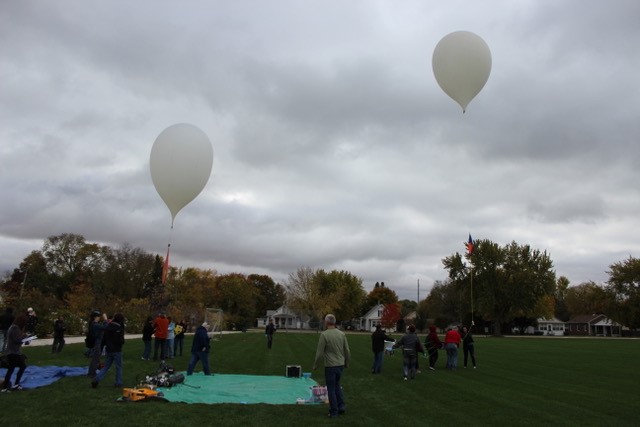 An October 2016 image of a high altitude balloon launch with DePaul University and Adler Planetarium Far Horizons Project. The balloons are about 8-feet wide at launch and filled with helium to rise. (Photo courtesy of Adler Planetarium Far Horizons Project)
An October 2016 image of a high altitude balloon launch with DePaul University and Adler Planetarium Far Horizons Project. The balloons are about 8-feet wide at launch and filled with helium to rise. (Photo courtesy of Adler Planetarium Far Horizons Project)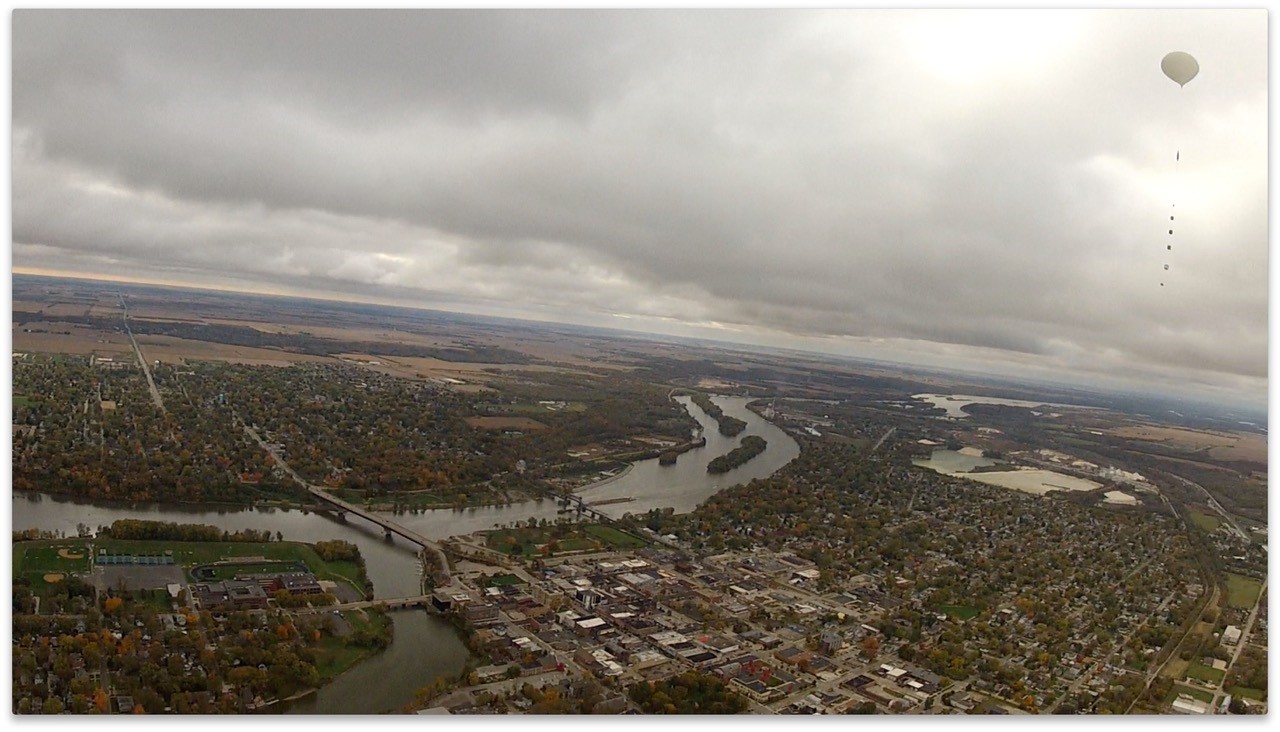 A DePaul University high altitude balloon from an October 2016 launch. (Photo courtesy of Adler Planetarium Far Horizons Project)
A DePaul University high altitude balloon from an October 2016 launch. (Photo courtesy of Adler Planetarium Far Horizons Project)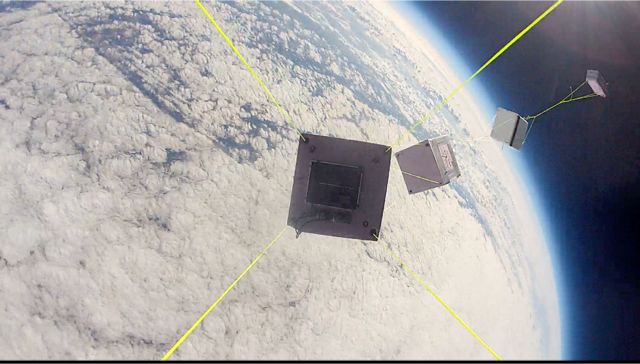 An October 2016 image of Earth and instruments attached to strings from a DePaul University high altitude balloon. (Photo courtesy of Bernhard Beck-Winchatz)
An October 2016 image of Earth and instruments attached to strings from a DePaul University high altitude balloon. (Photo courtesy of Bernhard Beck-Winchatz)